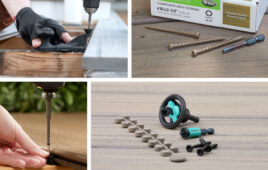John R. Gyorki
Editorial Director
If solder works well in your design, then you probably do not need to replace it with an electrically conductive adhesive. Adhesives usually cost more and have a few functional limitations that might not make them suitable for attaching traditional PCB components. However, you may want to use these adhesives when lead-free solder is giving you a problem, or when you are designing a new product that will get smaller with succeeding generations. The shift to lead-free solder, recent improvements in adhesive rheology, and a move within the electronics industry towards more flexible substrates, printed electronics, and miniaturization are making these materials a more viable option for many applications.
Lead-free does not mean problem-free
As companies continue to comply with RoHS laws, they have to make more lead-free products; however, some new problems are surfacing because of the lead-free solder. “Many of the issues relate to the thermally sensitive components used in products that cannot tolerate the lead-free solder reflow temperatures,” says Dr. Gunther Dreezen, Senior Business Scientist, New Product Development, Henkel Corp. Higher-end substrates, including Kapton®, can sustain high processing temperatures, so solder is not an issue. But, lower-cost packaging, such as PVC or PET cannot; it is more thermally sensitive. Electrically conductive adhesives work better for PVC and PET packages because they can be processed at much lower temperatures than those for lead-free solder. In addition, the adhesives are more flexible and can tolerate higher mechanical stress.

Certain materials, such as ceramic, LTCC, HTCC, and aluminum can be difficult to solder. But
conductive adhesives adhere reliably to various materials and metallization. Some cure at 125° C or less, which makes them compatible with low-cost, temperature-sensitive substrates.
“Electrically conductive adhesives are amenable to miniaturization,” says Walter Brenner, Technical Director, Master Bond, Inc. High temperatures can damage sensitive circuitry, and excessive heat can affect its performance — now and later in its life. “Miniaturization requires delicate instrumentation and devices that are heat sensitive; and solder requires heat,” says Brenner.
Electrically conductive adhesives are divided into two main types: isotropic and anisotropic. Isotropic adhesives are the most widely used because they conduct in all three axes; x, y, and z. Anisotropic adhesives conduct only in the vertical direction, and are typically reserved for specialty applications. Anisotropic adhesives cure in seconds under pressure, but some components cannot tolerate too much pressure. In contrast, isotropic adhesives do not require pressure to cure, but their cure time has traditionally been much longer — from a few minutes to 2 hours — depending on the application. Long cure time is a significant disadvantage when processing speed is a primary concern.
But all this has changed recently; new isotropic adhesives can cure in 10 seconds for certain applications, and they do not depend on pressure. As with all electrically conductive adhesives, they can be processed at much lower temperatures than solder; 110 to 200º C for adhesives, compared to 245 to 260º C for lead-free solder. “Since the adhesive can cure within ten seconds without pressure at a temperature low enough for a plastic substrate, high-speed application methods can be used. These include jet dispensing, as well as flexographic and screen printing,” says Dr. Stone Cheng, Senior Business Scientist, Henkel Corp.
Reliability
Corrosion resistance
The most widely used components are low-cost and usually have tin-plated terminals. But most silver-filled adhesives are not compatible with tin metallizations. According to Dreezen, “That is a major limitation, because if you want to attach those components with a conductive adhesive, temperature and humidity testing will produce corrosion.”
By using adhesives that have corrosion control, you can eliminate the need for costly components. “We add specific anti-corrosion agents to our adhesives that make them compatible with tin, so the corrosion process is stopped or delayed. During the life of the device you have a stable and reliable electrical contact,” Dreezen says. “In the past, you had to use noble-metal finished boards and components that were much more expensive.”
Mechanical strength
Adhesive manufacturers agree that electrically conductive adhesives will not soon replace solder in most applications. “With solders you are forming a metallic connection,” says Dreezen. But because adhesives are a different kind of interconnection, they make a bond that other methods cannot. For example, some manufacturers are interested in flexible or semi-flexible adhesives that can tolerate significant Coefficient of Thermal Expansion (CTE) mismatches when connecting large devices on the board, especially when a device can bend. “In these cases, electrically conductive adhesives are the only solution,” says Dreezen.

Most electrically conductive adhesives are isotropic, and they are formulated by adding conductive fillers, such as silver, gold, or nickel. They are mixed into various resins and polymers, such as epoxies, urethanes, and silicones. The resin is considered a binder that holds the particles together and develops adhesion. The particles touch each other, forming a network that conducts in all directions (x, y, and z). After the material properly cures, it becomes a conductive layer. 
Emerson & Cuming CA-3152 snap-cure adhesive attaches die straps to antennas for an RFID application. When it is subjected to repeated thermal shock and extended temperature and humidity testing, its conductivity levels with various metal surface combinations remain within the design specifications. The chart shows the dc resistance change of simulated RFID tags (a) after 2 weeks in 85°C/85% RH test, and (b) after 100 air-to-air thermal shock cycles (-40°C to 85°C).
“When you look at your washing machine, often you will see an LED that indicates its status. In this case, a flex circuit material uses a conductive adhesive for attachment,” says Cheng. Brenner adds, “In printed electronics, there is no question that conductive adhesives are going to make a big play.” Many touch screens now use indium tin oxide (ITO). The disadvantage to this material is that when it bends, it becomes brittle and cracks, and the touch screen no longer works well. “Silver conductive epoxy is not going to crack because it is malleable. As you pressurize it, it flows,” says Brenner.


Emerson & Cuming CA-3152 snap adhesive is jet dispensable at 40,000 dots per hour and snap curable in ten seconds at 135°C, which produces RFID tags at an extremely rapid line speed.
Impact resistance
Electrically conductive adhesives have lower impact resistance, but as Cheng indicates, you must factor in the size of the components. If your components are small, adhesives can do the job. He also says that people should drop-test their products. Various adhesive chemistries such as epoxies, urethanes, silicones, and other materials can be made flexible for better impact resistance,” says Cheng.

A typical high-temperature soldering process can damage thin-film PV modules. Emerson & Cuming conductive adhesive CE 3103 WLV bonds the metal wires in each PV cell to conduct the current out of the solar module. The advantages of using conductive adhesive for PV modules include a lower temperature, larger processing window, and higher processing yield.
Self-alignment
Adhesive bonds do not correct for misaligned parts, so the part will remain misaligned through the cure. In contrast, when the component is placed slightly out-of-position in a soldering process, the surface tension of the solder puts it in the correct position. However, Cheng says that by improving placement accuracy for adhesives, proper alignment is less of a concern. He also noted that despite its self-alignment properties, the solder process does not always guarantee proper placement. Sometimes, when the wetting force unbalances during reflow soldering, leadless components may stand up or one end may rise. This is called “tomb stoning.”
Cost
Adhesive manufacturers usually agree that cost is probably the biggest factor, because lead-free solder contains silver, copper, and tin. Silver is the most expensive, dominant conductive filler used in electrically conductive adhesives because others do not provide the level of conductivity required. In addition, a higher amount of silver is needed to achieve conductivity. It must be loaded into the adhesive to exceed the percolation point. The percolation point is the level at which the particles begin to contact each other to form a conductive network.
“One of the most interesting features of adhesives that may not be widely known is that the amount of material you need is significantly less compared to solder paste. Typical solder paste stencil printing requires a stencil thickness from about 100 to 220 µm. With electrically conductive adhesives, this is cut in half; stencil thicknesses then range from 50 to 70 µm,” Dreezen says. DW
Henkel Corp.
www.henkel.com
Emerson & Cuming
www.emersoncuming.com
Master Bond, Inc.
www.masterbond.com
Think ahead
Design considerations
When you plan to design a new device, three primary factors may determine whether conductive adhesives should be considered.
• What is your design going to look like five years from now? If it is going to be smaller, lighter, or
contain more functions, it may be worthwhile to consider an adhesive.
• Can your components handle the higher temperatures required for the solder reflow process?
• Two years from now, will the device be 1/10 the size or cost half as much?
Don’t expect a drop-in
Compared to solder, conductive adhesive has different processing characteristics, and you may need to specify it into your design and learn how to work with it early in the design stage. Otherwise, you could encounter issues later on. What’s more, you do not need to upgrade your production line significantly; often, you can use your traditional production equipment. However, you cannot run an adhesive on the same line and expect to process it in the same way as solder. “An adhesive is not a drop-in replacement. But time spent on education may be worth the extra effort,” says Dreezen.
Overcome solder hierarchy
Adhesives can be used alongside solder in the same assembly to overcome an issue called solder hierarchy. Often, different types of materials need to be processed — some more often than the others. Each time the assembly is processed, it becomes more sensitive to heat. To overcome the problem, a higher temperature solder can be used for the first assembly pass. When the assembly is ready to process a second material, a lower temperature solder is used, so the higher temperature solder will remain in position.
Adhesives do not have this problem after the materials cure. At higher temperatures, they may soften but not move. In some applications, you can use an adhesive to attach the components on the circuits that are sensitive to additional reflow processing. “The assembly might not even have to be reflowed,” says Cheng.
::Design World::





Tell Us What You Think!